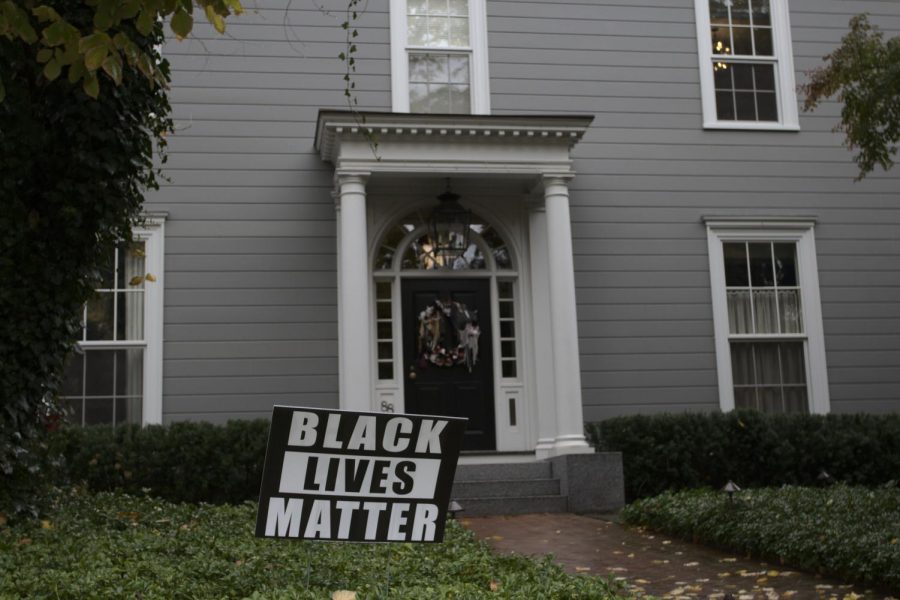Selective Activism in Cambridge: The Hypocrisy of Supporting BLM but not Public Housing
A Black Lives Matter sign outside of a house in Cambridge
October 29, 2020
It is no secret that the population of Cambridge generally identifies with the progressive left. Support for civil rights advocacy groups, such as the Black Lives Matter (BLM) movement, has been at an all-time high. Cambridge also boasts one of the highest costs of living in the entire nation; the average price for a single-family home is a staggering $744,500. For comparison, the average property value in neighboring Waltham is nearly half, at $497,100. For many white supporters of groups like BLM, housing may not come to mind as a frontline issue, and for some, housing equality is something that doesn’t even garner their support. Yet some of the most significant hurdles that minorities face in modern America—income inequality, education, and healthcare—can all be traced back to issues surrounding fair and equal housing. Thus, it is hypocritical for Cambridge residents to support movements that call for racial equality while also opposing affordable housing development in their neighborhoods that would achieve the goals of these movements.
Cambridge has a long history of segregation in neighborhoods and schools, but the modern landscape of housing in the city didn’t begin until rent control was dropped in 1998. Rent control effectively maintained an availability of affordable housing. Since then, real-estate development has largely consisted of expensive one and two bedroom homes, with cheaper options hotly contested by the large college student population. This creates a cycle that results in a skyrocketing housing market, where high income families move in, further increasing demand and prices. For individuals and families looking for reasonably priced apartments, Cambridge has become nearly inaccessible, forcing them to nearby cities like Everett, Malden, Watertown, and Lynn. This process can be classified as gentrification: the erasure of people of color, immigrants, and poor people who were once part of the vibrant fabric of Cambridge, replaced with upper middle class white families.
Efforts to divert this cycle of gentrification have been met with harsh resistance from the very same population that claims to strongly support efforts for racial and social justice. The people with signs supporting the BLM movement in their front lawns are the same people who form “neighborhood associations.” They shelve their outright racism and replace it with innocuous sounding terms such as “maintaining the neighborhood identity,” or citing increased crime rates as a reason to bar construction of affordable housing near their homes. While the concerns that drive the resistance to public housing in Cambridge today are somewhat valid—such as increased noise, pollution, or traffic—and cannot be blamed solely on subconscious racism, it is not a coincidence that many of the main arguments put forth by those against affordable housing development are the same excuses used to justify the segregation and unequal access to housing in the 50s and 60s. These excuses are catalysts that created the wealth gap—they are racist and untrue. Studies have shown that public housing neither increases crime rate nor pollution in said area, nor does it lower property values. The argument against public housing in a neighborhood simply boils down to the stigma white families have towards African American communities.
Housing is directly linked to the very issues that groups like BLM advocate to solve. Profiling and over-policing happens because neighborhoods are segregated, thus a single minority group is targeted. The enormous gap in wealth between Black and white families can be pinned mostly on the fact that white families were able to enter high income communities and build equity through their homes, while African Americans were denied that right, clustered into ghettos, and robbed of equal funding. When affordable housing is constructed, it allows a broader range of socioeconomic classes to have access to quality education that was once reserved for those inside the closed walls of predominantly white communities. Since affordable housing and the goals of Black Lives Matter go hand in hand, white allies must check their own prejudices and be willing to allow socioeconomic integration in order to truly support positive change in the scope of civil rights.










